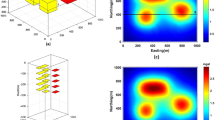Abstract
Psychophysical experiments show that the perceived colour of an object is relatively independent of the spectrum of the incident illumination and mainly depends on the surface spectral reflectance. We first demonstrate a possible solution to this undetermined problem for a Mondrian world of flat rectangular patches. We expand the illumination and surface reflectances in terms of a finite number of basis functions. We assume that the number of colour receptors is greater than the number of basis functions. This yields a set of nonlinear equations for each colour patch. Number counting arguments show that, given a sufficient number of surface patches with the same illumination, there are enough equations to determine the surface reflectances up to an overall scaling factor. This theory is similar to previous and independent work by Maloney and Wandell (Maloney 1985). We demonstrate a simple method of solving these non-linear equations. We generalize to situations where the illumination varies in space and the objects are three dimensional shapes. To do this we define a method for detecting material changes, a colour edge detector, and illustrate a way of detecting the colour of a material at its boundaries and propagating it inwards.
Similar content being viewed by others
References
Blake A (1983) The least-disturbance principle and weak constraints. Pattern Recognition L 1:393–399
Blake A (1984) On lightness computation in mondrian world. In: Zeki S (ed) Central and peripheral mechanisms of colour vision. Macmillan, London, pp 213–221
Brill MH (1978) A device performing illuminant-invariant assessment of chromatic relations. J Theor Biol 71:473–478
Brill MH, West G (1981) Contributions to the theory of invariance of colour under the condition of varying illumination. J Math Biol 11:337–350
Buchsbaum G, Goldstein JL (1979) Optimum probabilistic processing in colour perception. II. colour vision as template matching. Proc R Soc Lond [Biol] 205:249–266
Buchsbaum G, Gottschalk A (1983) Trichromacy, opponent colours coding and optimum colour information transmission in the retina. Proc R Soc Lond [Biol] 220:89–113
Buchsbaum G, Gottschalk A (1984) Chromaticity coordinates of frequency-limited functions. J Opt Soc Am 1:885–887
Canny JF (1983) Finding edges and lines in images. Art Intell Lab Rep TR 720
Cook RL, Torrance KE (1982) A reflectance model for computer graphics. ACM Trans Graph 1:7–24
Feynman RP (1963) The Feynman lectures on physics, vol 1. Addison-Wesley, Reading, Massachusetts
Geman S, Geman D (1984) Stochastic relaxation, Gibbs distributions and the bayesian restoration of images. IEEE Trans Patt Anal Mach Intell 6:721–741
von Helmholtz HLF (1896) Handbuch der Physiologischen Optik, 2nd edn. Hamburg Leipzig, Voss
Horn BKP (1974) On lightness. C.V.G.I.P. 3:277–299
Hurlbert A (1986) M.I.T. A.I. Memo No. 814 (to appear)
Land EH (1974) The retinex theory of colour vision. Proc R Inst G B 47:23–58
Land EH (1983) Recent advances in retinex theory and some implications for cortical computations: colour vision and the natural image. Proc Natl Acad Sci USA 80:5163–5169
Maloney J, Wandell B (1986) Color constancy: a method for recovering surface spectral reflectance. J Opt Soc Am (in press)
Maloney J (1985) Computational approaches to color constancy. PhD Thesis. Applied Psychology Laboratory. Stanford University
Marr D, Hildreth E (1980) Theory of edge detection. Proc R Soc Lond [Biol] 207:187–217
McCann JJ, McKee S, Taylor TH (1976) Quantitative studies in retinex theory: a comparison between theoretical predictions and observer responses to the colour Mondrian experiments. Vision Res 16:445–458
Phong BT (1975) Illumination for computer generated pictures. Communications A C M, 18. 6:311–317
Poggio T and staff (1985) MIT Progress in understanding images. Proc Image Understanding Workshop, Florida pp 25–39
Rubin J, Richards W (1984) Colour Vision: Representing Material Categories. MIT AI Memo No 764
Sallstrom P (1973) Colour and physics: some remarks concerning the physical aspects of human colour vision. University of Stockholm: Inst Phys Rep 73-09
Stiles WS, Wyszecki G, Ohta N (1977) Counting metameric object-colour stimuli using frequency-limited spectral reflectance functions. J Opt Soc Am 67:779–784
Wandell B, Maloney J (1984) Computational methods for color identification. Talk presented at Opt Soc Am annual meeting. San Diego
West G, Brill MH (1982) Necessary and sufficient conditions for Von Kries chromatic adaption to give colour constancy. J Math Biol 15:249–258
Witkin AP (1982) Intensity-based edge classification Proc AAAI:36–41
Yuille AL (1984) A method for recovering spectral reflectance. MIT AI Memo No 752
Author information
Authors and Affiliations
Additional information
This report describes research done at the Artificial Intelligence Laboratory of the Massachusetts Institute of Technology. Support for the laboratory's artificial intelligence research is provided in part by the Advanced Research Projects Agency of the Department of Defense under Office of Naval Research contract N00014-80-C-0505
Rights and permissions
About this article
Cite this article
Yuille, A. A method for computing spectral reflectance. Biol. Cybern. 56, 195–201 (1987). https://doi.org/10.1007/BF00317994
Received:
Revised:
Issue Date:
DOI: https://doi.org/10.1007/BF00317994




